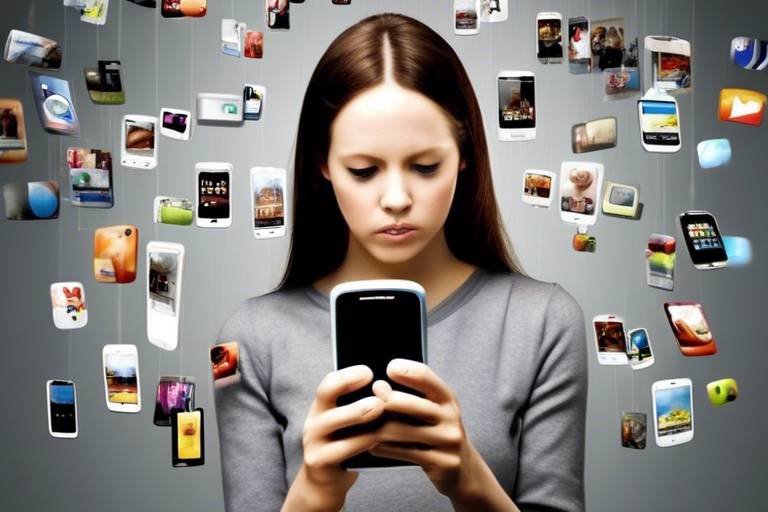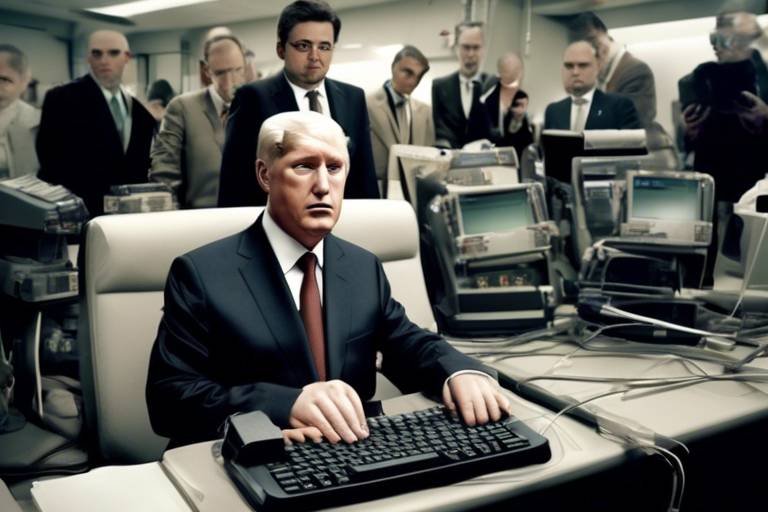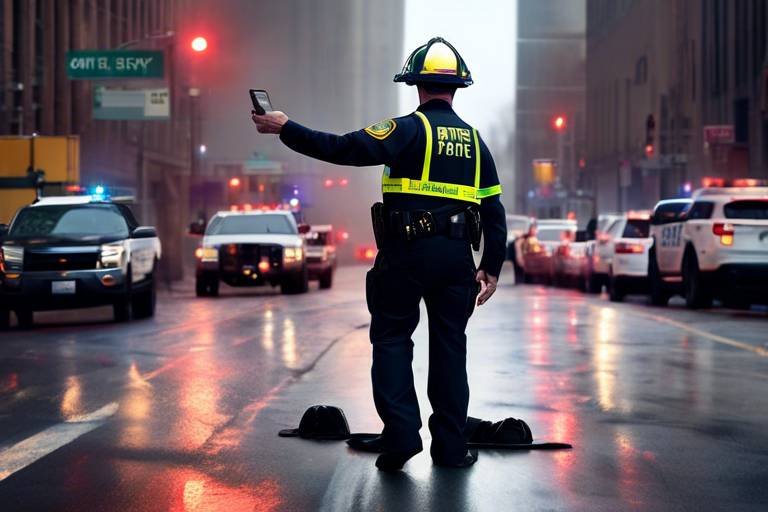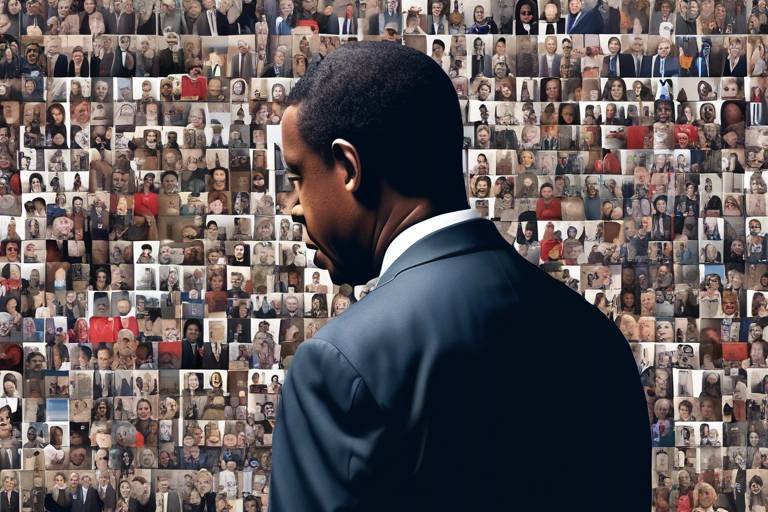The Role of Virtual Reality in Social Experiences
Virtual Reality (VR) is not just a buzzword anymore; it's a revolutionary technology that is reshaping the way we interact socially. Imagine stepping into a world where the boundaries of physical distance dissolve, allowing you to connect with friends, family, or even strangers from across the globe in a shared digital space. Sounds exciting, right? This article delves into how VR is transforming social interactions, enhancing connections, and crafting immersive experiences that redefine communication in various settings, from gaming to virtual gatherings.
The beauty of VR lies in its ability to create a sense of presence. When you put on a VR headset, you’re not just watching a screen; you’re transported into a different reality where you can see, hear, and even feel as if you are truly there. This feeling of immersion is what makes VR a powerful tool for social experiences. It allows users to engage in shared activities, whether it’s playing a game, attending a concert, or simply hanging out with friends in a virtual café. The possibilities are endless and incredibly exciting!
Moreover, VR is breaking down geographical barriers. You could be in New York while your friend is in Tokyo, yet you can still meet in a virtual environment as if you were in the same room. This capability is particularly beneficial in today's increasingly globalized world, where people often find themselves separated by continents. Virtual Reality fosters a sense of community, allowing users to build relationships that might not have been possible otherwise. It’s like having a passport to a universe of social interactions!
As we explore the various applications of VR in social settings, it becomes clear that this technology is not just a trend; it’s a fundamental shift in how we communicate and connect. From gaming to remote work, education, and beyond, VR is enhancing our social experiences in ways we are just beginning to understand. So, buckle up as we dive deeper into the evolution of virtual reality and its profound impact on our social lives!

The Evolution of Virtual Reality
This article explores how virtual reality (VR) is transforming social interactions, enhancing connections, and creating immersive experiences that redefine communication in various settings, from gaming to virtual gatherings.
The journey of virtual reality (VR) is nothing short of fascinating, resembling a rollercoaster ride filled with technological breakthroughs and imaginative visions. The concept of VR can be traced back to the 1960s with the invention of the Sensorama, a machine that offered a multi-sensory experience by combining 3D visuals, audio, and even smells. It was a glimpse into a future where technology could transport us to different realms.
Fast forward to the 1980s, and we see the advent of the Virtuality Group, which introduced arcade machines equipped with headsets that allowed players to immerse themselves in virtual worlds. However, it wasn't until the 1990s that VR began to gain mainstream attention, thanks to companies like SEGA and Nintendo, who experimented with VR gaming consoles. Unfortunately, the technology of that era was limited, leading to a quick decline in interest.
It wasn't until the 2010s that VR truly began to blossom again, propelled by advancements in technology and a surge of interest from the gaming community. The release of the Oculus Rift in 2016 marked a significant milestone, as it brought affordable and high-quality VR experiences to consumers. This resurgence opened the floodgates for innovation, leading to a plethora of VR headsets and applications that we see today.
Here are some pivotal milestones in the evolution of VR:
- 1962: Morton Heilig creates the Sensorama, an early multi-sensory experience.
- 1985: The Virtuality Group develops arcade machines with VR capabilities.
- 1991: SEGA announces the SEGA VR headset, although it never reaches the market.
- 2012: Oculus VR launches a Kickstarter campaign that ignites interest in modern VR.
- 2016: Oculus Rift and HTC Vive are released, marking a new era for consumer VR.
As we delve deeper into the present day, VR technology continues to evolve at a breakneck pace. With the integration of artificial intelligence and machine learning, the experiences are becoming more personalized and immersive. Today, VR isn't just a tool for gaming; it's a platform for social interaction, education, and professional training. The possibilities are endless, and as we look to the future, we can only imagine the new realms of connection and communication that await us.
Exploring how VR facilitates social interactions, allowing users to engage in shared experiences, collaborate, and communicate in ways that transcend geographical barriers.
Examining the impact of VR on gaming communities, where players can connect, socialize, and compete in immersive environments that enhance camaraderie and competition.
An overview of popular VR platforms that foster social gaming experiences, enabling users to interact and build relationships through shared gameplay.
Analyzing how VR influences player dynamics, including teamwork, communication, and competition, ultimately shaping the social fabric of gaming communities.
Discussing the role of VR in remote work settings, where virtual environments facilitate collaboration, meetings, and team-building activities among geographically dispersed teams.
Investigating how virtual reality is used in educational settings to create immersive learning experiences, allowing students to collaborate and interact in a virtual classroom environment.
Exploring the concept of virtual classrooms, where students can engage in interactive lessons and group activities, enhancing their learning experience through social interaction.
Highlighting the use of VR for professional training simulations, providing a safe space for trainees to practice skills and collaborate with peers in realistic scenarios.
What is Virtual Reality?
Virtual Reality is a simulated experience that can be similar to or completely different from the real world, often involving the use of special equipment like headsets and controllers.
How does VR enhance social interactions?
VR allows users to engage in shared experiences, collaborate in real-time, and communicate with others in a virtual space, breaking down geographical barriers.
Is VR only for gaming?
No, while gaming is a significant aspect of VR, it is also used in education, training, and remote work settings to enhance collaboration and learning experiences.
What are some popular VR platforms?
Some popular VR platforms include Oculus Rift, HTC Vive, PlayStation VR, and Valve Index, each offering unique social and gaming experiences.

Virtual reality (VR) is not just a technological marvel; it's a bridge connecting people in ways that were once unimaginable. Imagine stepping into a digital realm where the constraints of distance dissolve, and you can interact with friends, family, or even strangers from across the globe. This immersive technology has revolutionized social interaction, allowing users to engage in shared experiences that feel incredibly real. Whether you're exploring a virtual world, attending a concert, or simply hanging out in a digital café, VR offers a unique platform for connection.
One of the most significant advantages of VR is its ability to create a sense of presence, making users feel as though they are truly "there" with others. This sensation is akin to being in the same room, despite being physically miles apart. The emotional engagement that VR fosters can lead to deeper connections, as users share experiences that evoke laughter, excitement, or even nostalgia. It's like having a conversation over coffee, but instead, you're sharing a thrilling adventure in a fantasy landscape.
Moreover, VR enhances communication by incorporating non-verbal cues that are often lost in traditional digital interactions. In a virtual space, gestures, facial expressions, and body language can be mimicked, allowing for a more authentic exchange. This aspect is crucial, especially in settings where emotional context matters. For instance, during collaborative projects or team-building exercises, being able to see and interpret these non-verbal signals can significantly improve understanding and rapport among participants.
Another fascinating facet of VR is its role in fostering new friendships and communities. Users can join virtual worlds or platforms where they can meet like-minded individuals, participate in activities, or even engage in competitions. This creates a vibrant social ecosystem where relationships can blossom. Think of it as a digital playground where everyone is invited to join in on the fun, regardless of their physical location.
In addition to gaming and casual interactions, VR also plays a pivotal role in professional networking. Virtual conferences and meet-ups have become increasingly popular, especially in a world that is leaning towards remote work. These events allow professionals to connect, share ideas, and collaborate without the limitations of geography. Imagine attending a conference where you can walk up to a virtual booth, chat with industry leaders, and even exchange contact information—all from the comfort of your home. It’s a game-changer!
To summarize, the impact of virtual reality on social interaction is profound. It not only enhances the way we communicate but also redefines the essence of socializing in our increasingly digital world. As VR technology continues to evolve, we can only anticipate even more innovative ways it will shape our social experiences.
- What is virtual reality?
Virtual reality is a simulated experience that can be similar to or completely different from the real world. It uses technology to create immersive environments that users can interact with.
- How does VR enhance social interaction?
VR enhances social interaction by creating a sense of presence, allowing users to communicate through gestures and expressions, and enabling shared experiences that deepen connections.
- Can VR be used for professional networking?
Yes, VR is increasingly used for professional networking through virtual conferences and meet-ups, allowing individuals to connect and collaborate from anywhere in the world.
- What are some popular VR platforms for social interaction?
Some popular VR platforms include Oculus, VRChat, and Sansar, which provide immersive environments for socializing, gaming, and collaboration.

Virtual reality (VR) has taken the gaming world by storm, creating vibrant communities where players can immerse themselves in fantastical worlds while connecting with others. Imagine stepping into a digital universe where you can not only see your friends but also interact with them in real-time, just like you would in the physical world. This is the magic of VR in gaming communities, where the boundaries of reality blur, and social interaction becomes a thrilling adventure.
One of the most exciting aspects of VR gaming is the shared experience. Players can join forces or compete against one another in ways that traditional gaming simply can't match. Whether it’s teaming up to conquer a challenging quest or engaging in friendly competition, the immersive nature of VR fosters a sense of camaraderie that is hard to replicate. Players find themselves laughing, strategizing, and celebrating victories together, creating bonds that often extend beyond the game itself. In fact, many players report forming lasting friendships through these virtual interactions, which is a testament to the power of shared experiences in a digital landscape.
Moreover, VR gaming communities are not just about the games; they offer a platform for social engagement that transcends geographical barriers. Players from different corners of the world can come together in a virtual space, breaking down the limitations of distance. This global connectivity allows for diverse interactions and the exchange of ideas, cultures, and gaming strategies. Imagine a gamer in Tokyo teaming up with another in New York to tackle a complex challenge—this is the new frontier of social gaming, where the world becomes your playground.
However, the impact of VR on gaming communities goes beyond just social interactions; it also influences player dynamics. In a virtual environment, communication takes on new forms. Players can use voice chat, gestures, and even body language to convey emotions and intentions, enhancing teamwork and collaboration. This immersive communication style fosters a deeper understanding among players, making it easier to coordinate strategies and respond to challenges in real-time. The result? A more cohesive team dynamic that elevates the overall gaming experience.
To illustrate the influence of VR on gaming communities, let’s take a look at some popular VR platforms that have revolutionized the way players connect:
| Platform | Key Features | Community Engagement |
|---|---|---|
| Oculus Quest | Wireless gameplay, social spaces | Multiplayer games, events |
| SteamVR | Wide range of games, modding support | Community hubs, forums |
| PlayStation VR | Exclusive titles, integration with PS4 | Online multiplayer, social features |
As the VR landscape continues to evolve, the potential for gaming communities to grow and thrive is limitless. With advancements in technology, we can expect even more immersive experiences that will redefine how we connect and interact with others in the gaming world. So, whether you’re a seasoned gamer or just starting, the world of VR gaming communities offers a unique opportunity to forge connections, share experiences, and be part of something truly extraordinary.
- What is virtual reality gaming? Virtual reality gaming involves the use of VR technology to create immersive gaming experiences where players can interact with a 3D environment and other players.
- How does VR enhance social interactions in gaming? VR enhances social interactions by allowing players to communicate and collaborate in real-time, creating a sense of presence and shared experience that traditional gaming lacks.
- Can I make friends through VR gaming? Absolutely! Many players form lasting friendships through shared experiences in VR gaming communities.
- What are some popular VR gaming platforms? Some popular VR gaming platforms include Oculus Quest, SteamVR, and PlayStation VR, each offering unique features and community engagement opportunities.

When it comes to social gaming, virtual reality platforms are at the forefront, revolutionizing how players connect, interact, and compete. Imagine stepping into a digital realm where your friends are not just usernames on a screen but actual avatars you can see, hear, and interact with. This immersive experience brings a whole new dimension to gaming, making it feel more like a real-life gathering than just a solo endeavor. Platforms such as Oculus Quest, PlayStation VR, and SteamVR have emerged as leaders in this space, each offering unique features that cater to different gaming preferences and social interactions.
For instance, the Oculus Quest allows users to enjoy a wide range of multiplayer games, from action-packed shooters to collaborative puzzle games. Players can join friends in virtual environments, strategizing and communicating in real-time as if they were in the same room. The seamless integration of voice chat and motion tracking makes every interaction feel genuine, fostering a sense of camaraderie that traditional gaming often lacks.
On the other hand, PlayStation VR has carved its niche by offering exclusive titles that emphasize social gaming. Games like Rec Room and VRChat are designed specifically for social interaction, allowing players to create their own avatars, customize their spaces, and engage in various activities together. These platforms not only provide entertainment but also serve as virtual hangout spots where friendships can blossom, regardless of physical distance.
Furthermore, SteamVR offers a vast library of games that cater to diverse interests, from cooperative adventures to competitive esports. The platform is known for its Steam Workshop, where players can create and share content, enhancing the social gaming experience by allowing others to join in on the fun. This collaborative spirit is what makes VR gaming so appealing; it transforms solitary play into a shared journey, where players can celebrate victories and navigate challenges together.
In conclusion, the rise of these VR platforms has not only changed the way we play games but has also redefined social interaction in the gaming world. As we continue to embrace this technology, the possibilities for connection and community are endless, paving the way for a future where virtual friendships are just as meaningful as those formed in the physical world.
- What are the best VR platforms for social gaming? The best platforms include Oculus Quest, PlayStation VR, and SteamVR, each offering unique features and a variety of social gaming experiences.
- Can you play VR games with friends who don't have VR? Some VR games offer cross-platform play, allowing VR users to interact with players on traditional consoles or PCs, but it depends on the game.
- Is VR gaming safe for social interaction? Yes, as long as users follow safety guidelines and take breaks to avoid discomfort, VR can provide a safe and enjoyable social gaming experience.

When it comes to virtual reality (VR) gaming, the effects on player dynamics are nothing short of revolutionary. Imagine stepping into a digital arena where every move, every gesture, and every word spoken carries weight. This immersive experience fosters a sense of presence and connection that traditional gaming simply cannot replicate. Players are no longer just avatars on a screen; they are part of a living, breathing world where their actions have real consequences.
One of the most significant impacts of VR on player dynamics is the enhancement of teamwork. In many multiplayer VR games, players are required to collaborate closely to achieve objectives. This collaboration fosters a spirit of camaraderie, as players must communicate effectively and strategize together. For instance, in a VR escape room game, each player might need to take on a specific role—one could be solving puzzles while another gathers clues. This interdependence not only strengthens relationships but also enhances the overall gaming experience.
Moreover, VR influences communication styles among players. With the ability to use voice chat, body language, and even facial expressions, players can express themselves in more nuanced ways. This creates a more engaging and realistic interaction, allowing players to form deeper connections. Imagine playing a game where you can see your teammate's excitement or frustration through their avatars' movements—this level of engagement can turn casual players into lifelong friends.
However, the effects of VR on player dynamics extend beyond just teamwork and communication. Competition also takes on a new dimension in virtual environments. Players are often more invested when they can physically see and hear their opponents. This heightened sense of rivalry can lead to more intense gaming sessions, where players push each other to their limits. But it’s essential to strike a balance; while competition can be thrilling, it’s crucial to maintain a healthy gaming environment where all players feel valued and respected.
In addition to teamwork and competition, VR also enhances the social fabric of gaming communities. Players often form guilds or clans, which serve as social hubs within the game. These groups not only facilitate gameplay but also create a sense of belonging. The shared experiences within these communities can lead to friendships that extend beyond the game itself, as players connect over shared interests and experiences.
To summarize, the effects of VR on player dynamics are profound and multifaceted. From fostering teamwork and enhancing communication to intensifying competition and building community, VR is reshaping how players interact in gaming environments. As technology continues to evolve, we can only anticipate even more exciting developments in how players connect and engage with one another in virtual spaces.
- How does VR enhance communication in gaming?
VR allows players to use voice chat, body language, and facial expressions, creating a more immersive and engaging communication experience. - Can VR gaming lead to real-life friendships?
Yes! Many players form lasting friendships through shared experiences in virtual environments, often extending their connections outside of gaming. - What role does teamwork play in VR games?
Teamwork is crucial in many VR games, as players often need to collaborate to achieve objectives, enhancing the overall experience and fostering camaraderie. - How does competition in VR differ from traditional gaming?
Competition in VR is often more intense due to the immersive nature of the environment, allowing players to physically see and hear their opponents.

In today’s fast-paced world, where remote work has become the norm for many, virtual reality (VR) is stepping in to revolutionize how we collaborate and connect with our colleagues. Imagine stepping into a virtual office where you can see and interact with your teammates as if they were right there with you. This is not just a dream; it’s a reality that VR technology is making possible. With the right VR tools, the barriers of distance dissolve, allowing for a more immersive and engaging work experience.
One of the most significant advantages of using VR for remote work is the ability to create immersive meeting environments. Instead of the usual video calls that can feel flat and uninspiring, VR meetings allow participants to feel present in a shared space. You can walk around a virtual conference room, interact with 3D presentations, and even use virtual whiteboards to brainstorm ideas together. This level of interaction can enhance creativity and productivity, making meetings feel more dynamic and less monotonous.
Furthermore, VR can facilitate team-building activities that are often overlooked in remote settings. Traditional team-building exercises can be challenging to execute when everyone is scattered across different locations. However, VR opens up a world of possibilities. Teams can engage in virtual escape rooms, collaborative problem-solving tasks, or even fun games that promote camaraderie and trust. These experiences help to forge stronger relationships among team members, which is crucial for effective collaboration.
Of course, the technology isn’t without its challenges. Not everyone has access to VR headsets or the necessary hardware, which can create disparities in remote work experiences. However, as VR technology continues to evolve and become more affordable, we can expect to see a wider adoption across various industries. Companies that invest in VR tools for remote work might find themselves at a competitive advantage, attracting talent who value innovative and engaging work environments.
In summary, the integration of virtual reality into remote work settings is not just about enhancing communication; it’s about creating a holistic work experience that bridges the gap between physical and virtual interactions. As we continue to navigate the future of work, embracing VR technology could be the key to unlocking new levels of collaboration, creativity, and connection among remote teams.
- What is Virtual Reality (VR)? VR is a simulated experience that can be similar to or completely different from the real world, often involving the use of headsets and other equipment.
- How does VR enhance remote work? VR enhances remote work by creating immersive environments for meetings, team-building activities, and collaborative projects, making interactions more engaging.
- Are VR tools expensive? While some VR tools can be costly, prices are decreasing as technology advances, making it more accessible for businesses.
- Can VR replace traditional office spaces? While VR can enhance remote work experiences, it is unlikely to completely replace physical office spaces, as both have their unique advantages.

Virtual reality (VR) is not just a tool for entertainment; it’s revolutionizing the way we learn and train. Imagine stepping into a world where you can practice a surgical procedure without any risk, or explore ancient civilizations as if you were really there. This is the magic of VR in education and training! By creating immersive environments, VR allows students and professionals alike to engage in experiences that are not only interactive but also deeply impactful.
One of the most exciting aspects of VR in education is the concept of virtual classrooms. In these digital spaces, students can gather from anywhere in the world, breaking down the geographical barriers that often limit traditional learning. Picture a classroom filled with students from different continents, all collaborating on a project in real-time. This kind of interaction fosters a sense of community and enhances the learning experience. With VR, students can participate in interactive lessons that go beyond textbooks, engaging with content in a way that is both fun and educational.
Moreover, VR is proving to be invaluable in professional training simulations. Industries such as healthcare, aviation, and manufacturing are leveraging VR to create realistic training scenarios. Trainees can practice their skills in a safe environment, making mistakes without real-world consequences. For example, a medical student can perform virtual surgeries, gaining experience and confidence before they ever step into an operating room. This hands-on approach not only accelerates learning but also improves retention of complex concepts.
Consider the following benefits of incorporating VR into education and training:
- Enhanced Engagement: The immersive nature of VR captures attention and keeps learners engaged.
- Safe Learning Environment: Students can experiment and learn from their mistakes without fear of failure.
- Real-World Skills: Trainees can practice skills in realistic scenarios that are difficult to replicate in traditional settings.
- Global Collaboration: Learners from different backgrounds can work together, fostering diverse perspectives.
As VR technology continues to advance, its applications in education and training are only expected to grow. Schools and organizations are beginning to recognize the potential of VR to create engaging learning experiences that prepare students for the challenges of the real world. However, it’s important to note that the integration of VR into education is not without its challenges, such as the need for appropriate hardware and software, as well as the training of educators to effectively use these tools.
In conclusion, the role of virtual reality in education and training is transformative. It opens up a world of possibilities for learners of all ages, enabling them to explore, interact, and engage in ways that were once unimaginable. As we continue to embrace this technology, the future of education looks brighter than ever, paving the way for more effective and inclusive learning experiences.
- What is virtual reality in education? Virtual reality in education refers to the use of VR technology to create immersive learning experiences, allowing students to engage with content in interactive ways.
- How does VR enhance learning? VR enhances learning by providing safe, engaging, and interactive environments where students can practice skills and collaborate with others.
- Are there any challenges to using VR in education? Yes, challenges include the cost of VR equipment, the need for specialized software, and the requirement for educators to be trained in using VR tools effectively.
- What fields benefit the most from VR training? Fields such as healthcare, aviation, and technical training benefit significantly from VR, as it allows for realistic practice without real-world risks.

Imagine stepping into a classroom where the walls are made of clouds, and the teacher is a hologram guiding you through the mysteries of the universe. Virtual reality (VR) is making this dream a reality, transforming traditional education into an engaging and immersive experience. In virtual classrooms, students can interact with their peers and instructors in ways that transcend the limitations of physical space. This technology not only enhances learning but also fosters a sense of community among students who might otherwise feel isolated.
One of the most exciting aspects of virtual classrooms is the ability to create interactive learning environments. Students can participate in group activities, collaborate on projects, and engage in discussions, all while feeling as if they are physically present with their classmates. This immersive experience helps to break down barriers that often exist in conventional learning settings, allowing for a more inclusive and participatory approach to education.
Furthermore, VR enables students to explore complex subjects through simulation and visualization. For example, a biology class can take a virtual field trip to the Amazon rainforest, allowing students to observe ecosystems in real-time. This hands-on learning approach not only captures students' attention but also enhances their understanding of the material.
Moreover, the social aspect of virtual classrooms cannot be overstated. Students can form friendships and networks that extend beyond the confines of the classroom. They can share experiences, collaborate on assignments, and even celebrate achievements together, creating a vibrant community of learners. This sense of belonging is crucial for student engagement and motivation.
To illustrate the effectiveness of virtual classrooms, consider the following table that compares traditional classrooms with virtual ones:
| Feature | Traditional Classrooms | Virtual Classrooms |
|---|---|---|
| Physical Presence | Required | Not required |
| Interaction | Limited to in-person | Real-time, immersive |
| Learning Environment | Static | Dynamic and customizable |
| Access to Resources | Restricted to classroom materials | Unlimited digital resources |
As we navigate through this digital age, the potential of VR in education is becoming increasingly clear. It is not just about learning; it’s about creating a holistic educational experience that prepares students for the future. By incorporating VR into the curriculum, educators can cultivate critical thinking, creativity, and collaboration skills that are essential in today’s world.
In conclusion, virtual classrooms represent a revolutionary shift in the way we approach education. They offer a unique blend of technology and social interaction, making learning more engaging and effective. As this technology continues to evolve, we can only imagine the endless possibilities it holds for future generations.
- What equipment do I need for virtual classrooms? Most VR classrooms require a VR headset, a compatible computer or console, and a stable internet connection.
- Are virtual classrooms suitable for all age groups? Yes, virtual classrooms can be tailored to suit various age groups, from young children to adults.
- How do virtual classrooms enhance learning? They provide immersive experiences, promote interaction, and allow for exploration of complex subjects in engaging ways.

In the rapidly evolving landscape of professional development, virtual reality (VR) has emerged as a revolutionary tool for training simulations. Imagine stepping into a lifelike environment where you can practice your skills without the fear of real-world consequences. This is the magic of VR training! It allows individuals to engage in realistic scenarios that mimic their actual work environments, from medical procedures to emergency response situations. The immersive nature of VR not only enhances learning but also boosts confidence among trainees.
One of the most significant advantages of VR in professional training is its ability to provide a safe space for practice. Trainees can make mistakes, learn from them, and refine their skills without any risk. For example, a surgeon can practice complex surgical procedures multiple times in a virtual operating room, gaining invaluable experience before ever stepping into a real one. This hands-on approach ensures that when trainees finally face real-life situations, they're prepared and competent.
Additionally, VR simulations can be tailored to meet the specific needs of various industries. Whether it's a corporate setting, healthcare, or emergency services, VR can create customized scenarios that reflect the unique challenges of each field. Here are a few examples of how different sectors utilize VR training simulations:
- Healthcare: Medical professionals can simulate surgeries, patient interactions, and emergency responses, enhancing their decision-making skills.
- Corporate Training: Employees can engage in team-building exercises and leadership training in a controlled, virtual environment.
- Emergency Services: First responders can practice crisis management and rescue operations in realistic simulations, preparing them for high-pressure situations.
Moreover, VR training can foster collaboration among peers. Trainees can work together in virtual environments, allowing them to communicate, strategize, and solve problems as a team. This collaborative aspect is crucial, especially in fields where teamwork is essential for success. By engaging in VR simulations, individuals develop not only their technical skills but also their interpersonal skills, which are vital in any professional setting.
As we look to the future, the potential of VR in professional training is limitless. With advancements in technology, we can expect even more realistic and engaging simulations that will transform the way we approach learning and development. The integration of artificial intelligence and machine learning into VR training could lead to personalized learning experiences, adapting to the pace and style of each individual trainee. This means that the future workforce will not only be well-trained but also equipped with the skills needed to thrive in an ever-changing job market.
In conclusion, professional training simulations powered by virtual reality are redefining how we prepare individuals for their careers. By providing immersive, safe, and collaborative learning environments, VR is not just enhancing skills—it's revolutionizing the entire training process.
Q: What industries benefit the most from VR training simulations?
A: Industries such as healthcare, corporate training, emergency services, and aviation significantly benefit from VR training simulations, as they require high levels of skill and teamwork.
Q: How does VR training improve retention of information?
A: The immersive experience of VR engages multiple senses, which enhances memory retention and allows trainees to remember information better than traditional methods.
Q: Is VR training suitable for all learning styles?
A: Yes! VR training can be tailored to accommodate various learning styles, making it an effective tool for visual, auditory, and kinesthetic learners alike.
Frequently Asked Questions
- What is virtual reality (VR)?
Virtual reality (VR) is a technology that creates a simulated environment, allowing users to immerse themselves in a three-dimensional space. It often involves the use of VR headsets and controllers to interact with the virtual world, making experiences feel incredibly real.
- How does VR enhance social interactions?
VR enhances social interactions by allowing users to connect in virtual spaces, share experiences, and communicate in real-time, regardless of their physical location. This creates a sense of presence and engagement that traditional communication methods can't match.
- Can VR be used for remote work?
Absolutely! VR is revolutionizing remote work by providing virtual environments for meetings, collaboration, and team-building activities. This technology fosters a more interactive and engaging workspace, helping teams feel more connected even when they are miles apart.
- What are some popular VR platforms for social gaming?
Some popular VR platforms for social gaming include Oculus Quest, PlayStation VR, and SteamVR. These platforms offer a variety of games and experiences that promote social interaction and collaboration among players.
- How does VR impact player dynamics in gaming communities?
VR significantly impacts player dynamics by enhancing teamwork, communication, and competition. Players can interact more naturally and engage in shared experiences, leading to stronger bonds and a more vibrant gaming community.
- What are virtual classrooms in VR?
Virtual classrooms in VR are immersive learning environments where students can participate in interactive lessons and group activities. This setup enhances the learning experience by promoting collaboration and social interaction among students.
- How is VR used in professional training?
VR is used in professional training to create realistic simulations where trainees can practice skills in a safe environment. This hands-on approach allows for collaboration with peers and boosts confidence before entering real-world scenarios.



















